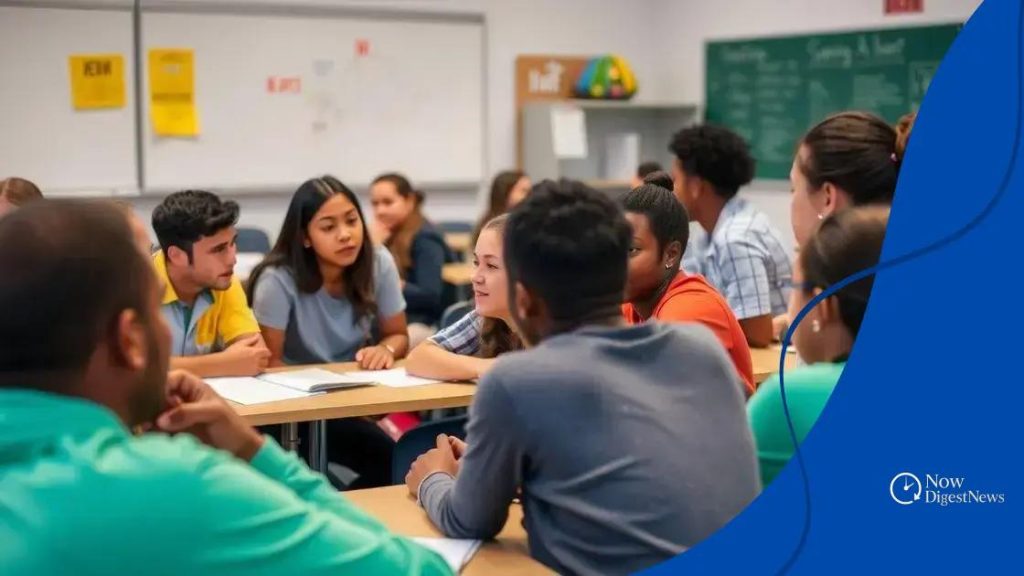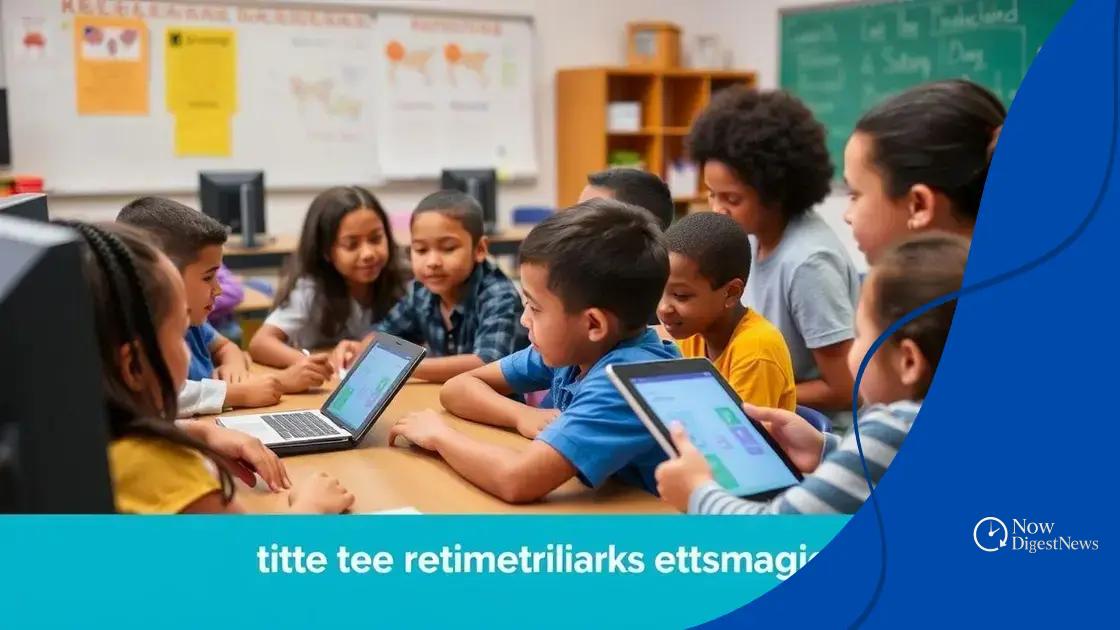Addressing learning gaps: strategies for success

Anúncios
Addressing learning gaps involves recognizing individual needs, utilizing technology for personalized support, and implementing effective strategies, empowering educators to enhance student success.
Addressing learning gaps is crucial in today’s educational landscape. Have you noticed how some students struggle while others excel? This article explores practical strategies to support those who need extra help.
Anúncios
Understanding learning gaps
Understanding learning gaps is the first step in helping students succeed. These gaps can occur for various reasons, and it’s essential to recognize them early. When students face challenges in their learning journey, identifying these gaps can pave the way for targeted interventions.
What Are Learning Gaps?
Learning gaps refer to the discrepancies between what students are expected to learn and what they actually understand. These gaps can arise from a lack of foundational knowledge, differences in learning styles, or external factors such as family circumstances.
Causes of Learning Gaps
There are several reasons why students might experience learning gaps:
Anúncios
- Insufficient prior knowledge in key subjects.
- Diverse learning styles not being addressed.
- External distractions and challenges affecting focus.
When schools and educators understand these causes, they can better support their students.
Additionally, learning gaps can vary significantly among different students, which means that personalized approaches are necessary. Some students may struggle with math while excelling in reading, while others may face the opposite situation. Therefore, recognizing these individual differences is crucial.
Using assessments can provide insights into students’ current knowledge and help identify specific areas where they may be falling behind. Early intervention can then create an environment where students feel supported.
Identifying causes of learning gaps
Identifying the causes of learning gaps is essential for addressing educational challenges. When teachers and parents understand why these gaps exist, they can implement more effective strategies.
Common Causes of Learning Gaps
Many factors contribute to learning gaps, and recognizing them can lead to better support for students. Here are some typical causes:
- Poor foundational skills in earlier grades.
- Different learning speeds among students.
- Lack of access to resources or support.
Each of these factors can create significant challenges. For instance, a student who struggles with basic math might find it hard to tackle more advanced concepts later on.
In addition, external factors also play a role. Issues such as family instability or health problems can greatly impact a student’s ability to learn. Teachers must be aware of these circumstances to provide appropriate support.
Furthermore, it’s important to think about teaching styles. Some students may not connect well with traditional methods. Understanding different learning styles can help educators tailor their techniques to better fit their students’ needs.
Data from assessments can illuminate these gaps further, allowing for targeted interventions. By assessing students regularly, teachers can pinpoint areas of struggle and adjust their teaching accordingly.
Engaging students in discussions about their learning can also reveal underlying issues. When students express their concerns, educators gain valuable insight, and a more supportive environment can be created.
Effective strategies for remediation

Effective strategies for remediation can significantly help bridge learning gaps. When students encounter difficulties, it is crucial to provide them with targeted support to help them catch up and thrive academically.
Differentiated Instruction
Differentiated instruction is a key strategy in addressing varying learner needs. This approach involves tailoring lessons to meet different abilities and learning styles.
- Provide varied resources and materials.
- Adapt techniques based on student responses.
- Utilize small group work to foster collaboration.
By applying these methods, teachers can create engaging lessons that resonate with each student, leading to improved outcomes.
Frequent Assessment
Using frequent assessments can help track progress effectively. Regular quizzes and informal checks can provide insights into students’ understanding, allowing for timely adjustments in teaching methods.
Assessments should not only gauge knowledge but also reflect how well students can apply what they learn. Monitoring growth helps to pinpoint areas needing further attention.
Additionally, incorporating feedback loops encourages students to reflect on their learning. Discussions about assessment results can promote ownership and motivation to improve.
Another effective approach involves using tutoring and peer support systems. Pairing students can allow for collaborative learning, where they help each other grasp challenging concepts. This not only reinforces their understanding but also builds confidence.
Incorporating technology into remediation strategies can also yield great benefits. Online platforms provide interactive practice and can engage students in ways traditional methods may not. Educators can use apps and websites tailored to specific subjects to reinforce skills and concepts.
Role of teachers in addressing gaps
The role of teachers in addressing learning gaps is vital for student success. They serve not only as educators but also as guides who can help students overcome obstacles in their learning journey.
Recognizing Individual Needs
Teachers must recognize that each student learns differently. By identifying individual strengths and weaknesses, educators can tailor their instruction to meet diverse needs. This targeted approach encourages students to engage with the material more effectively.
- Use formative assessments to gauge understanding.
- Adapt teaching methods to suit different learning styles.
- Provide personalized feedback to help students improve.
When teachers focus on the unique needs of each student, they help build a more inclusive learning environment.
Building Relationships
Establishing strong relationships with students is crucial. When students feel valued and understood, they are more likely to participate and take risks in their learning. Teachers can create a supportive atmosphere by showing empathy and encouragement.
Moreover, open communication fosters trust. Students should feel comfortable sharing their challenges. By keeping the lines of communication open, teachers can better identify and address specific gaps.
Another important aspect is involving parents. Teachers can collaborate with families to create a support system. By keeping parents informed about their child’s progress, they can work together to reinforce learning at home.
Incorporating innovative teaching strategies is another way teachers can address gaps effectively. Using technology, hands-on activities, and collaborative projects can engage students and enhance their understanding.
Staying informed about best practices allows teachers to adapt their methods as needed. Continuous professional development is crucial for keeping skills sharp and learning new strategies to support their students’ success.
Using technology to bridge learning gaps
Using technology to bridge learning gaps has transformed how educators support students. With the right tools, teachers can provide personalized learning experiences that cater to each student’s needs.
Interactive Learning Tools
Interactive learning tools allow students to engage with the material in dynamic ways. These tools can include:
- Educational apps that reinforce skills through games.
- Online platforms for collaborative projects.
- Virtual simulations that replicate real-world scenarios.
When students interact with the content, they often retain information better. These technologies can be especially beneficial for visual and kinesthetic learners.
Data-Driven Insights
Another advantage of using technology is the ability to gather data on student performance. Teachers can use analytics to identify where a student may be struggling. This information is crucial for addressing learning gaps effectively.
By analyzing assessment scores and engagement levels, educators can adjust their instructional strategies. They can determine which concepts need reinforcement and which students require additional assistance.
Moreover, learning management systems can track student progress over time, allowing for ongoing support and adjustments as needed. With real-time data, teachers can respond swiftly to emerging needs.
Additionally, technology can foster a more inclusive learning environment. Tools like text-to-speech software and speech recognition can help students with disabilities access the curriculum. This ensures that all learners can participate and succeed.
Blended Learning Approaches
Implementing blended learning approaches combines traditional teaching with digital resources. This model provides flexibility, allowing students to learn at their own pace.
In a blended learning environment, students might attend a conventional classroom while also engaging with online lessons. This combination can enhance participation and understanding, paving the way to close learning gaps.
Overall, embracing technology in education encourages innovation and engagement. As educators explore these options, they can create tailored solutions that meet diverse needs and enable all students to thrive.
FAQ – Frequently Asked Questions about Addressing Learning Gaps
What are learning gaps?
Learning gaps refer to the differences between what students are expected to learn and what they actually understand.
How can technology help in bridging learning gaps?
Technology provides interactive tools and data-driven insights, allowing for personalized learning experiences that engage students effectively.
What role do teachers play in addressing learning gaps?
Teachers are crucial in recognizing individual needs, building relationships, and providing tailored support to help students succeed.
Why is frequent assessment important?
Frequent assessments help track student progress, identify areas of struggle, and allow for timely adjustments in teaching methods.